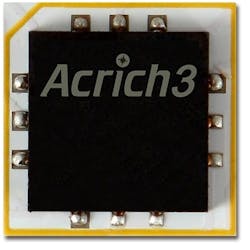Seoul Semiconductor announces Acrich3 AC-LED driver, new MJT LEDs
Seoul Semiconductor used LightFair International (LFI) as the platform to announce the next-generation Acrich3 AC-LED driver IC that can enable lower-cost light engines that work directly from the AC mains. Also leading into LFI, the company announced the Acrich MJT 5050 LED family that hits 141 lm/W in efficacy for cool-white components.
The Acrich3 IC is a follow-on product to the Acrich2 driver IC that was first announced as the heart of an LED light engine family of product back in 2011 and later promoted as a standalone IC product. The IC is indeed a good match for the high-voltage packaged LEDs that Seoul refers to as Multi Junction Technology (MJT) LEDs because each LED includes a number of series-connected emitters that result in the high input voltage that can also lead to more efficient driver stages. The Acrich2/3 driver ICs will also work with LEDs from other vendors.
Dimming enhancements
Acrich3 provides three primary improvements relative to the prior generation IC and two are in the area of dimming. The IC responds more smoothly to legacy triac or phase-controlled dimmers. Indeed, an LFI demonstration showed a light engine that responded smoothly across the scale with no evident sparkling or flicker and a very uniform appearance with the LEDs behind a simple diffuser.
But many professional applications also need to have good dimming support for schemes such as 0–10V dimming. Dave Neal, director of applications engineering at Seoul, asserts that the Acrich3 works much better with 0–10V dimmers, especially at the low-end of the dimming range where smooth low-light adjustment is key for lighting designers/specifiers.
Moreover, the better 0–10V support will lead to adoption of Acrich3 in smart lighting applications with network support, according to Neal. Such implementations require good 0–10V dimming support, and Neal said that the Acrich3 can be easily combined with microcontrollers to add support for ZigBee, Wi-Fi, Bluetooth, or other networks.
The final advantage comes in the area of the quality of the AC mains. Since Acrich3 is intended to connect directly to the mains, it is also inherently going to experience what can be a less than perfect input signal. Neal said that Acrich3 could adapt to line-voltage variations as great as 20% and still deliver power-level regulation within 5%. That feature will result in the more uniform lighting performance required in professional applications.
Seoul said that it will shortly deliver LED light engines based on the Acrich3 LED. Based on past offerings, you can expect modular products in a variety of round and rectangular form factors. Jay Kim, executive vice president of Seoul's lighting sales division, said "Seoul Semiconductor plans to launch several new modules with Acrich3 technology for the use in residential, commercial, and industrial lighting systems."
MJT 5050 LEDs
While not announced together, the Acrich3 IC would also work well with the new MJT 5050 LEDs launched the week prior to LFI. The 5×5-mm LEDs deliver typical output of 180 lm at 20 mA of drive current and can be driven as high as 60 mA.
The new LEDs specifically target the outdoor lighting market. According to Seoul's Kim, the LEDs offer the combination of high efficacy required in street lights and a low total cost of ownership (TCO) when combined with AC-driver technology. The TCO assertion refers to the fact that the driver electronics in an AC-LED system are far simpler and occupy a very small footprint directly on a light engine as opposed to DC-LED products that often use a more-bulky and separate modular driver.
The MJT 5050 LEDs come in 3000K CCT warm-white and 5000K CCT cool-white versions. At 20 mA of drive current at 25°C operating conditions, the LEDs deliver 121 lm/W and 141 lm/W, respectively. The cooler LEDs feature a CRI of 70 and the warmer versions a CRI of 80.






